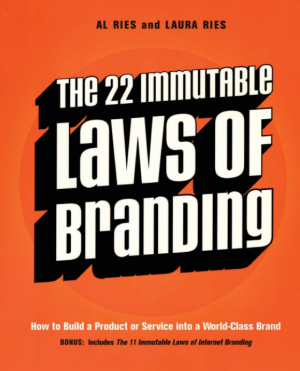22 Immutable Laws of Branding
22 Immutable Laws of Branding is a marketing book written by Al and Laura Ries.
The book presents a list of rules in order to help business owners grow their brands and businesses.

The 22 Laws of Branding Written by Al and Laura Ries
- The law of expansion: the power of a brand is inversely proportional to its scope "Marketers constantly run branding programs that conflict with how people want to perceive their brands. Customers want brands that are narrow in scope and are distinguishable by a single word, the shorter, the better."
- The law of contraction: a brand becomes more potent when you narrow its focus.
- The law of publicity: the birth of a brand is achieved with promotion, not advertising Ries and Ries maintain that advertising is best used to maintain a brand, but that it is challenging and expensive to launch a new brand through advertising alone they best way, they say, is to be first in a new product or service category, and reap the attendant publicity.
- The law of advertising: once born, a brand needs advertising to stay healthy.
- The law of the word: a brand should strive to own a word in the mind of the consumer "If you want to build a brand, you must focus your branding efforts on owning a word in the prospect's mind. A word that nobody else owns." (p.39) Examples they give include: Mercedes = prestige; Volvo = safety; Kleenex = tissue; Xerox = copier; FedEx = overnight.
- The law of credentials: the crucial ingredient in the success of any brand is its claim to authenticity, and the best claim to authenticity is the top product or service in your category because consumers assume that if it is a top seller, it must be right:
"Never forget leadership. No matter how small the market, don't get duped into only selling the category's benefits. There are also long-term benefits to leadership. Because once you get on top, it's hard to lose your spot. A widely-publicized study of twenty-five leading brands in twenty-five different product categories in 1923 showed that twenty of the same twenty-five brands are still the leaders in their classes today. In seventy-five years, only five brands lost their leadership."
- The law of quality: is essential, but brands are not built by quality alone In fact, as the authors point out, most people have no idea as to the "real" rate of a product or service. Is a Rolex better at keeping time than a Timex? How do you know?
- The law of the category: a leading brand should promote the product or service category, not the brand This may seem counter-intuitive. Still, the authors argue that the best way for the brand leader to build sales is to promote the category, not their specific brand. This is a more effective way to build up overall market awareness and interest. The band leader will naturally benefit to a greater degree than other competitors by their larger market share. (And when the overall size of the market is built up, then the leader is in an excellent position to increase market share still further.)
- The law of the name: in the long run, a brand is nothing more than a name.
- The law of extensions: the easiest way to destroy a brand is to put its name on everything.
- The law of fellowship: to build the category, a brand should welcome other brands.
- The generic law: one of the fastest routes to failure is giving a brand a generic name. Generic names (i.e., words that describe the product or service category, such as "Wine Coolers"), do not firmly position the product or service within the class and are liable to confuse potential customers.
- The law of the company: Brands are brands. Companies are companies. There is a difference.
"The issue of how to use a company name is at the same time, both simple and complicated. Simple, because the laws are so clear-cut. They are complicated because most companies do not follow the simple branding laws and end up with a system that defies logic and results in endless brand versus company debates.
Brand names should almost always take precedence over company names. Consumers buy brands; they don't believe companies. So when a company name is used alone as a brand name (GE, Coca Cola, IBM, Xerox, Intel), customers see these names as brands."
- The law of sub brands: what branding builds, sub-branding (i.e., brand extensions) can destroy. The name 'Chevrolet' used to stand for something. Now, what is it? A large, small, cheap, expensive car or truck.
- The law of siblings : There is a time and a place to launch a second brand. "The key to a family approach is to make each sibling a unique individual brand with its own identity. Resist the urge to give the brands a family look or identity. You want to make each brand as different and distinct as possible."
- The law of shape : A brand's logotype should be designed to fit the eye. Both eyes. The authors argue that the ideal form for a logotype or brand symbol is two and a quarter units wide and one unit high.
- The law of color: A brand should use a color that is the opposite of its major competitors.
- The law of borders: There are no barriers to global branding. A brand should know no boundaries.
- The law of consistency: A brand is not built overnight; Success is measured in decades, not years.
- The law of change: Brands can be changed, but only infrequently and very carefully.
- The law of mortality: No brand will live forever. Euthanasia is often the best solution.
- The law of singularity: the essential aspect of a brand is its single-mindedness.
External Links
http://www.consulttci.com/Book_reviews/Immutable_Laws_of_Branding.html